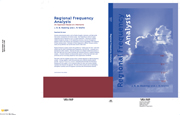Book contents
- Frontmatter
- Contents
- Preface
- Errata
- Chapter 1 Regional frequency analysis
- Chapter 2 L-moments
- Chapter 3 Screening the data
- Chapter 4 Identification of homogeneous regions
- Chapter 5 Choice of a frequency distribution
- Chapter 6 Estimation of the frequency distribution
- Chapter 7 Performance of the regional L-moment algorithm
- Chapter 8 Other topics
- Chapter 9 Examples
- Appendix: L-moments for some specific distributions
- References
- Index of notation
- Author index
- Subject index
Chapter 1 - Regional frequency analysis
Published online by Cambridge University Press: 30 October 2009
- Frontmatter
- Contents
- Preface
- Errata
- Chapter 1 Regional frequency analysis
- Chapter 2 L-moments
- Chapter 3 Screening the data
- Chapter 4 Identification of homogeneous regions
- Chapter 5 Choice of a frequency distribution
- Chapter 6 Estimation of the frequency distribution
- Chapter 7 Performance of the regional L-moment algorithm
- Chapter 8 Other topics
- Chapter 9 Examples
- Appendix: L-moments for some specific distributions
- References
- Index of notation
- Author index
- Subject index
Summary
Introduction
Frequency analysis is the estimation of how often a specified event will occur. Estimation of the frequency of extreme events is often of particular importance. Because there are numerous sources of uncertainty about the physical processes that give rise to observed events, a statistical approach to the analysis of data is often desirable. Statistical methods acknowledge the existence of uncertainty and enable its effects to be quantified. Procedures for statistical frequency analysis of a single set of data are well established. It is often the case, however, that many related samples of data are available for analysis. These may, for example, be meteorological or environmental observations of the same variable at different measuring sites, or industrial measurements made on samples of similar products. If event frequencies are similar for the different observed quantities, then more accurate conclusions can be reached by analyzing all of the data samples together than by using only a single sample. In environmental applications this approach is known as regional frequency analysis, because the data samples analyzed are typically observations of the same variable at a number of measuring sites within a suitably defined “region.” The principles of regional frequency analysis, however, apply whenever multiple samples of similar data are available.
Suppose that observations are made at regular intervals at some site of interest. Let Q be the magnitude of the event that occurs at a given time at a given site. We regard Q as a random quantity (a random variable), potentially taking any value between zero and infinity.
- Type
- Chapter
- Information
- Regional Frequency AnalysisAn Approach Based on L-Moments, pp. 1 - 13Publisher: Cambridge University PressPrint publication year: 1997
- 22
- Cited by



